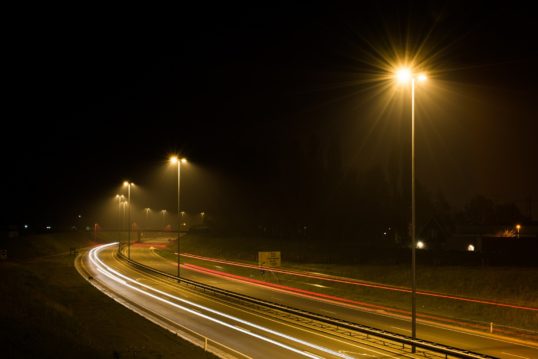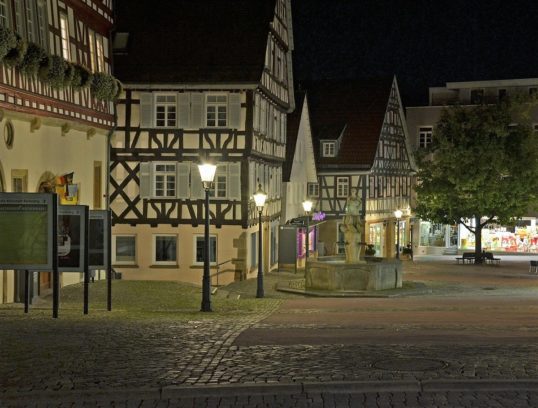
Why should you upgrade your existing lighting systems to the latest LED technology?
There are several options on the road to the energy transition: One of them is to retrofit outdated street lighting using the latest LED technologies. This is not only easy to implement, but also brings several advantages in terms of costs and the environment. BRAUN has therefore compiled 5 reasons that may help you in your decision-making process.
1. Save costs
Many businesses, municipalities and communities have always faced the problem of rising electricity consumption and associated costs. Much of this can be attributed to outdated lighting systems, which continue to demand large sums due to lagging technologies and frequent outages.
The optimal solution is to upgrade to intelligent lighting systems. The latest LED technology with high luminous efficacy and good color rendering can create a significant advantage with optimized light control and energy-saving control gear. With the help of modernization of outdated street lights, not only the costs but additionally the frequency of required maintenance work is reduced. The service life of the luminaires is extended and disposal costs are reduced to a minimum.

2. Environmentally friendly lighting
The major goal of reducing CO2 emissions and achieving resource-conserving use of our natural energies has never been more important than it is today. This challenge can be met in a number of ways, including efficient street lighting.
Even after a short period of time, modernizations can create additional synergies besides the high savings potential, helping the environment and creating a better future. Maximum benefit for people and nature alike can therefore be achieved if all components of a system contribute to higher lighting quality. This is achieved through long-life lamps, efficient luminaires, economical control gear and modern lighting management. With the help of directional light and selected color temperatures, light pollution and immission can thus be reduced or prevented altogether. LED streetlights in particular (approx. 420 nm to 780 nm) do not emit any UV radiation and therefore also attract fewer insects than conventional lighting solutions – this also protects wildlife.
3. More safety
First and foremost, street lighting serves to ensure general safety, both for vehicle and passenger traffic. Intelligently controlled light and adapted illumination can effectively prevent traffic accidents. Thus, not only the road traffic but also the safety of the citizens is guaranteed. The basis for this is a careful analysis and preceding light planning by specialists. In addition to European and national standards and directives, numerous technical lighting parameters must also be taken into account in order to make the lighting solution a success.
Correctly equipped paths and roadways can additionally strengthen the general feeling of safety among residents and increase visual comfort. To control shadowing, the radiation characteristics of the luminaires and their arrangement are determined.

4. Enhanced cityscape
In lighting technology, there are numerous characteristics that stand for and make up the quality of lighting. The quality is not only based on general vision, but also influences well-being and mood. In order to distribute light according to requirements, several factors must therefore be examined: Illuminance, luminance distribution, light color, light direction and limitation of glare.
Any type of glare reduces comfort and impairs visual performance. As soon as light from outdoor lighting is distributed unfavorably, penetrates into residential buildings and disturbs residents, it is referred to as nighttime light immissions. These are not only considered a harmful environmental impact, but also affect people and animals alike.
In order to prevent unfavorable glare and scattering into the night sky, a sophisticated light management system is required with the aid of intelligent control and targeted use of lighting. Among other things, sensors and dimming functions can be used to direct the light as needed. This not only increases the overall quality of light, but also enhances the entire cityscape.
5. Full luminosity
LEDs (Light Emitting Diodes) are electronic semiconductor crystals that emit colored or white light when current is applied. While conventional light sources require a certain amount of time to reach their full potential, LEDs shine immediately after being switched on. However, depending on the quality and efficiency of the light source, they also have different burning times. To keep the temperature of the integrated chip as low as possible, additional heat sinks are therefore usually used. This not only reduces general wear and tear, but also leads to longer lifetimes and greater luminous efficacy. Currently, the service life of LEDs is around 60,000 hours. Since the light-emitting diodes (usually assembled into LED modules) almost never fail in practice, the long service life promises additional freedom from maintenance.
As a specialist in historic and modern outdoor lighting, we are always available to help you find the optimal lighting solution for your project.
Call us directly or fill out the contact form!
